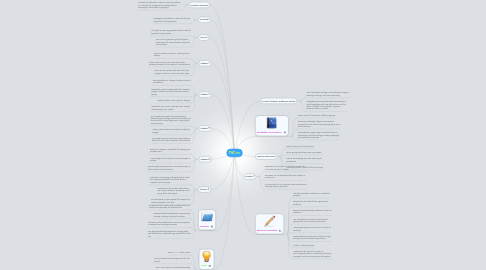TWC301
von Raquel Cortez

1. Processes
1.1. Be aware that it usually takes multiple drafts to create and complete a successful text
1.2. Develop flexible strategies for generating, revising, editing, and proof-reading
1.3. Understand the collaborative and social aspects of research and writing processes
1.4. Use appropriate technologies to manage data and information collected or generated for future use
2. Goals
2.1. Earn an "A" in this course
2.2. Try my hardest on all assignments for this course
2.3. Learn some basics in multimedia writing
3. Chapter 3
3.1. Contrast is used along with emphasis to catch the audiences attention and show what is important to the reader.
3.2. Contrast can be created with colors, size, shape, balance, proportion, and many other techniques.
3.3. Contrast adds a visual appeal that keeps the reader intrested in the text.
4. Chapter 4
4.1. Balance in design is important for making your purpose clear.
4.2. Visual weight is the illusion of actual weight on a page.
4.3. Symetry asymetry proportion and positioning can all be used to create balance.
5. Chapter 5
5.1. This chapter discusses the importance of different types of alignment and how they can be used such as text alignment, using a grid, and grouping.
5.2. Using a grid structure can help to unify your design.
5.3. The most common used text alignments are flush left, flush right, centered, and justified.
6. Chapter 6
6.1. Using repetition in design creates unity and consistency.
6.2. Repetition can be created with font, headers, images, bullets, and other elements used in design.
6.3. Gestalt refers to the unity of a design.
6.4. Repetition can create a design that's visually interesting to your reader.
7. Chapter 7
7.1. Flow is used as a visual or verbal guide in design.
7.2. Flow is also used to make the information presented easier for the reader to comprehend.
7.3. Flow can be created with font, font size, margins, columns, and many other ways.
8. Fair use
8.1. The right to use copyrighted material without payment or permission.
8.2. Fair use is a general right that applies even when the law provides no specific authorization.
9. Copyright
9.1. Copyright is granted for material that is an original form of expression.
10. Creative commons
10.1. Created for educators, authors, and many others as a way to use images and content without worrying so much about Copyright.
11. Critical Thinking, Reading & Writing
11.1. Use information, writing, and reading for inquiry, learning, thinking, and communicating
11.2. Integrate previously held beliefs assumptions, and knowledge with new information and the ideas of others to accomplish a specific purpose within a context
12. Knowledge of Conventions
12.1. Learn common formats for different genres
12.2. Develop knowledge of genre conventions ranging from structure and paragraphing to tone and mechanics
12.3. Understand an apply legal and ethical uses of information and technology including copyright and intellectual property
13. Rhetorical Knowledge
13.1. Identify, articulate, and focus on a defined purpose
13.2. Respond to the need of the appropriate audience
13.3. Respond appropriately to different rhetorical situations
13.4. Use conventions of format and structure appropriate to the rhetorical situation
13.5. Adopt appropriate voice, tone, and level of formality
13.6. Understand how each genre helps to shape writing and how readers respond to it
13.7. Write in multiple genres
13.8. Understand the role of a variety of technologies/media in accessing, retrieving, managinh, and communication information
14. Writing Instructions
14.1. Keeps list short and to the point
14.2. When giving instructions use commands
14.3. Make sure headings are clear and easy to understand
14.4. Most people won't read but skim and scan
15. Chapter 2
15.1. Emphasis can be used to show the importance of an idea, phrase, or word.
15.2. Emphasis can be developed by size, shape, or placement.
15.3. It's important to not over use emphasis because nothings seems important.


